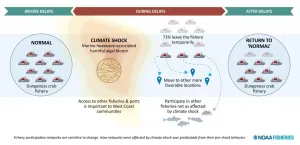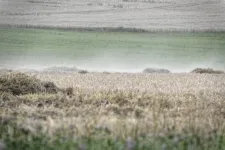AI algorithms detect diabetic eye disease inconsistently
Although some artificial intelligence software tested reasonably well, only one met the performance of human screeners, researchers found.
2021-01-05
(Press-News.org) Diabetes continues to be the leading cause of new cases of blindness among adults in the United States. But the current shortage of eye-care providers would make it impossible to keep up with demand to provide the requisite annual screenings for this population. A new study looks at the effectiveness of seven artificial intelligence-based screening algorithms to diagnose diabetic retinopathy, the most common diabetic eye disease leading to vision loss.
In a paper published Jan. 5 in Diabetes Care, researchers compared the algorithms against the diagnostic expertise of retina specialists. Five companies produced the tested algorithms - two in the United States (Eyenuk, Retina-AI Health), one in China (Airdoc), one in Portugal (Retmarker), and one in France (OphtAI).
The researchers deployed the algorithm-based technologies on retinal images from nearly 24,000 veterans who sought diabetic retinopathy screening at the Veterans Affairs Puget Sound Health Care System and the Atlanta VA Health Care System from 2006 to 2018.
The researchers found that the algorithms don't perform as well as they claim. Many of these companies are reporting excellent results in clinical studies. But their performance in a real-world setting was unknown. Researchers conducted a test in which the performance of each algorithm and the performance of the human screeners who work in the VA teleretinal screening system were all compared to the diagnoses that expert ophthalmologists gave when looking at the same images. Three of the algorithms performed reasonably well when compared to the physicians' diagnoses and one did worse. But only one algorithm performed as well as the human screeners in the test.
"It's alarming that some of these algorithms are not performing consistently since they are being used somewhere in the world," said lead researcher Aaron Lee, assistant professor of ophthalmology at the University of Washington School of Medicine.
Differences in camera equipment and technique might be one explanation. Researchers said their trial shows how important it is for any practice that wants to use an AI screener to test it first and to follow the guidelines about how to properly obtain images of patients' eyes, because the algorithms are designed to work with a minimum quality of images.
The study also found that the algorithms' performance varied when analyzing images from patient populations in Seattle and Atlanta care settings. This was a surprising result and may indicate that the algorithms need to be trained with a wider variety of images.
INFORMATION:
This study was supported by NIH/NEI K23EY029246, R01AG060942 and an unrestricted grant from Research to Prevent Blindness.
ELSE PRESS RELEASES FROM THIS DATE:
2021-01-05
Fishermen contend with regulations, natural disasters, and the ups and downs of the stocks they fish, along with many other changes. As a result, fishing communities are quite resilient. That is, they can withstand, recover from, and adapt to change.
But how much pressure can they stand? The 2014-2016 North Pacific marine heatwave, known as the Blob, led to a harmful algal bloom of unprecedented scale. It necessitated substantial delays in the opening of the 2015-16 U.S. West Coast Dungeness crab fishery. The fishery is vital to West Coast communities. It produces around 26 percent of all annual fishing revenue and supports more than 30 percent of all commercial fishing vessels.
Understanding ...
2021-01-05
Humans have consumed different types of fermented foods - from kimchi to yogurt - for thousands of years. Yet only recently, with the availability of new scientific techniques for analyzing their nutritional properties and microbiological composition, have scientists begun to understand exactly how the unique flavors and textures are created and how these foods benefit human health.
Now, 13 interdisciplinary scientists from the fields of microbiology, food science and technology, family medicine, ecology, immunology, and microbial genetics have come together to create the first international consensus definition of fermented ...
2021-01-05
Hotel managers have something in common beyond their reputations for charming dispositions and excellent listening skills - they're predominantly men, despite women making up the majority of the accommodations workforce. New research led by the University of Houston Conrad N. Hilton College of Hotel and Restaurant Management suggests hotel companies that promote a woman over an equally qualified man are perceived as fairer and less discriminatory, creating a stronger organizational culture and higher financial performance.
Published in the International Journal of Contemporary Hospitality Management, the study is the first to address gender inequity in promotional opportunities for hotel employees. The researchers surveyed 87 hotel ...
2021-01-05
DENVER/January 5, 2020 - Some English bulldogs diagnosed with a common cancer may instead have a newly described, non-cancerous syndrome called polyclonal B‐cell lymphocytosis. The discovery was made by Morris Animal Foundation-funded researchers at Colorado State University during a study to better understand B-cell chronic lymphocytic leukemia (BCLL). The team published their findings in the Journal of Veterinary Internal Medicine.
"This could save some dogs from being misdiagnosed, treated for cancer or even euthanized when they shouldn't be," said Dr. Anne Avery, Professor, Department of Microbiology, Immunology and Pathology at Colorado State University. "The dogs may look to their veterinarians like they ...
2021-01-05
BOSTON - (January 4, 2021) - As they age, people with diabetes are more likely to develop Alzheimer's disease and other cognitive disorders than are people without diabetes. Scientists at Joslin Diabetes Center now have shown that routine eye imaging can identify changes in the retina that may be associated with cognitive disorders in older people with type 1 diabetes.
These results may open up a relatively easy method for early detection of cognitive decline in this population, providing better ways to understand, diagnose and ultimately treat the decline, said George L. King, MD, Joslin's Chief Scientific Officer and senior author on a paper about the study in the Journal of Clinical Endocrinology & Metabolism.
Previous research had demonstrated an association ...
2021-01-05
To stop biodiversity loss, Canada recently committed to protecting 30% of its land and sea by 2030. But making conservation decisions about where to locate new protected areas is complicated. It depends on data both about biodiversity and about a range of benefits (e.g. freshwater, climate regulation, recreation) that people get from nature. Surprisingly, despite the size of the country, new mapping suggests that less than 1% of Canada's land (0.6% of total area or approximately 56,000 km2) is a hot spot, providing all these benefits in one place. Moreover, the study published today in Environmental Research Letters suggests that some of the most critical areas where people receive these key benefits from ...
2021-01-05
Leipzig. The transition from the Medieval Warm Period to the Little Ice Age was apparently accompanied by severe droughts between 1302 and 1307 in Europe; this preceded the wet and cold phase of the 1310s and the resulting great famine of 1315-21. In the journal Climate of the Past, researchers from the Leibniz Institutes for the History and Culture of Eastern Europe (GWZO) and Tropospheric Research (TROPOS) write that the 1302-07 weather patterns display similarities to the 2018 weather anomaly, in which continental Europe experienced exceptional heat and drought. Both the medieval and recent weather patterns resemble the stable weather patterns that have occurred more frequently since the 1980s due to the increased warming of the Arctic. ...
2021-01-05
A clear view of anatomical structures is vital for the success of surgery--especially in microsurgery where narrow anatomical cavities or proximity to vulnerable organs and tissues can pose significant risks to patient health. The surgical microscope has evolved to become a powerful tool for improving surgical visualization.
A END ...
2021-01-05
TROY, N.Y. -- A loss of enzymatic processes within the body can increase a person's risk of bone fracture. This new insight was recently published in eLife by an international team of scientists and engineers led by Deepak Vashishth, the director of the Center for Biotechnology and Interdisciplinary Studies (CBIS) at Rensselaer Polytechnic Institute.
Enzymatic processes are essential to any number of chemical reactions that occur within the body, including the production of the extracellular matrix within bone that is critical for mechanical support. Phosphorylation -- one of those key enzymatic processes -- is the attachment of a phosphoryl to a protein, and is critical for ...
2021-01-05
Worldwide, marine megafauna are at risk of extinction due to climate change, habitat loss, pollution, overhunting, population fragmentation, and hybridization with related species in areas disturbed by humans. Genetic studies can help determine the conservation status of marine animals, identifying threats to species conservation and informing interventions and policies, such as the protection of diversity hotspots or corridors for gene flow.
In a new study in Frontiers in Marine Science, researchers for the first time measured genetic diversity in manatees ...
LAST 30 PRESS RELEASES:
[Press-News.org] AI algorithms detect diabetic eye disease inconsistently
Although some artificial intelligence software tested reasonably well, only one met the performance of human screeners, researchers found.







